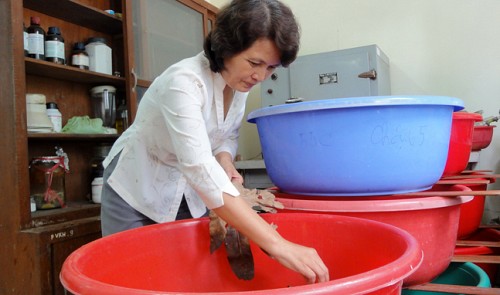Dr. Hoang Ngoc Anh, a pioneer of her field in the country, has dedicated almost 25 years to the study of scorpions and the use of their venom in antidotes, ointments, and painkillers.
Dr. Hoang Ngoc Anh, a pioneer of her field in the country, has dedicated almost 25 years to the study of scorpions and the use of their venom in antidotes, ointments, and painkillers.
Anh, who works at the Vietnam Academy of Science and Technology, has set local records for her devotion, achievements, and the many projects on scorpions and their venom she has successfully conducted.
The 61-year-old scientist got hooked on venom and its amazing medicinal properties in 1983, when she was working on her dissertation in the former Soviet Union. She defended her dissertation and began extensive research on venom with her groundbreaking discovery of the M9 toxin’s spatial structure from the venom of a scorpion breed called Buthus eupeus.
Coming from Vietnam, she knew her homeland, with its tropical climate, was home to a wide variety of venomous animals and insects.
In 1989, she traveled around the southern region of Vietnam and brought dozens of brown scorpions home to Hanoi. When preparing her research, Anh realized that no venom extracting machine had been built in the country.
Undaunted, she delved into French materials on electric pulse machines and their mechanisms and searched for someone to build her a machine.
Impressed with Anh’s passion, one of her colleagues, who didn’t specialize in building machinery, agreed to build the special machine as an experiment. Thus, the country’s first venom-extracting machine came into being.
Anh then went on with other tasks such as storing, culturing, and identifying the scorpions.
In the late 1980s, when the country was in dire times and access to outside information remained limited, local scientists named the brown scorpions incorrectly. In 2003, Anh sent her specimens to a famed scorpion classifier working at a museum in Paris, who identified the breed as Lychas mucronatus.
In 2002, she returned to Vietnam and began to breed scorpions to collect their venom. However, the scorpions were unable to adapt to Hanoi’s climate, and they all died.
One year later, Anh decided to breed the arachnid herself in southern Binh Phuoc province. After two months, she raised 3,500 scorpions with her unique breeding procedures, quite different from those she had learned earlier in school.
She recalls that at the outset, she kept the scorpions in boxes and they devoured one another. She then put them in large pots topped with dried leaves and wet grass and fed them with rickets and grasshoppers to make sure they were well-fed to prevent them from eating each other.
She settled in the south in 2006 and continued to breed scorpions, raising around 5,000 at a time.
Anh said she was once bitten in the arm by a brown scorpion. The sting left her paralyzed for half a day.
The incident incited in her a dream of making massage cream, ointments, and topical painkillers from scorpions’ venom and, after researching the process, she was able to do just that.
Prof. Le Quang Nghiem, from HCMC Medical University, who supervised Anh’s project, believes that her massage cream and painkillers from scorpion venom can be produced on a large scale.
Anh’s drugs fetch relatively high prices on the local market. For instance, Escozine 120ml, which contains extracts from blue scorpions, sell for VND15 million (US$711) per 120ml.

























































